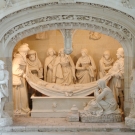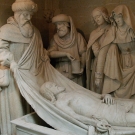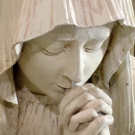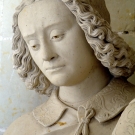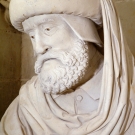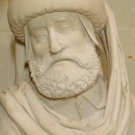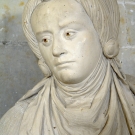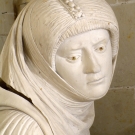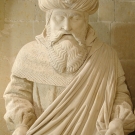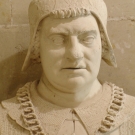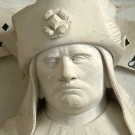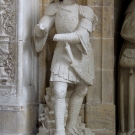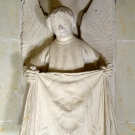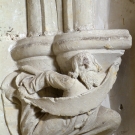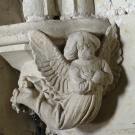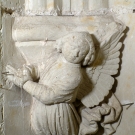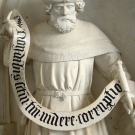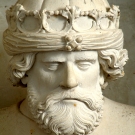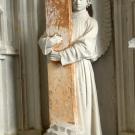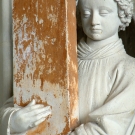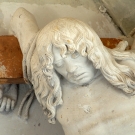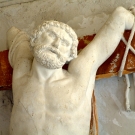South Transept
The Tomb of Our Lord in the south transept was completed c. 1496. This date, which is engraved on the right pilaster, is confirmed by the arms on the entablature, which are those of King Charles VIII, his wife Anne de Bretagne and the Dauphin, Charles-Orland.
This monument is entirely devoted to the passion and resurrection of Christ. It serves as a sort of reliquary monument for the relic of the Holy Thorn. The recess to hold this relic can be seen hanging from the arch in the monument’s lower section. In the upper section, the plain crucifix (empty since the body has just been entombed) stands on Calvary, which is symbolised by a skull. An angel is holding the crucifix tightly in its arms. Two thieves are on either side of the crucifix, together with an angel on the left holding the whipping column and lashes and another angel on the right carrying the spear and reed. There are two more angels above these: one holding the crown of thorns and another the nails and tunic of Christ.
The Prophet Isaiah and King David appear up to the waist in the recesses of the upper register, each holding a phylactery. The statue of David, to whom the Book of Psalms is attributed, bears the following inscription: “For thou dost not let thy godly one see the Pit” (Ps 16: 10). The statue of Isaiah has the following: “His sepulchre shall be glorious” (Is 11: 10). These are both prophecies of the resurrection. But the monument does not just evoke the death of Jesus: it is also filled with the hope of his resurrection.
The lower section is devoted to Christ's entombment. In addition to Christ, various figures mentioned in the Gospels are found here, all looking at Christ’s face. At Christ's head is Joseph of Arimathea, who owns the tomb. A man traditionally acknowledged to be Nicodemus is at his side. The Blessed Virgin, supported by St John, is in the centre. Two other female saints are on her left: Mary, the mother of James, and Salome. A figure dressed as a knight is standing opposite Joseph of Arimathea. He probably represents the donor who made this work of art possible. Lastly, Mary Magdalene is at the foot of the tomb, sitting in prayer. She is depicted in penitents’ clothing. Her serene face, which together with Christ's is the only one not frowning, expresses her faith and prayer. Mary, who is described by Jesus as having “chosen the better part” (Lk 10: 42), is the model of the contemplative life. On either side, two Roman soldiers are guarding the tomb. Their hands were broken and faces smashed by overly zealous pilgrims.
To the left of this monument is a Burgundian pietà under an altar. We have proof of its presence as early as 1477.




